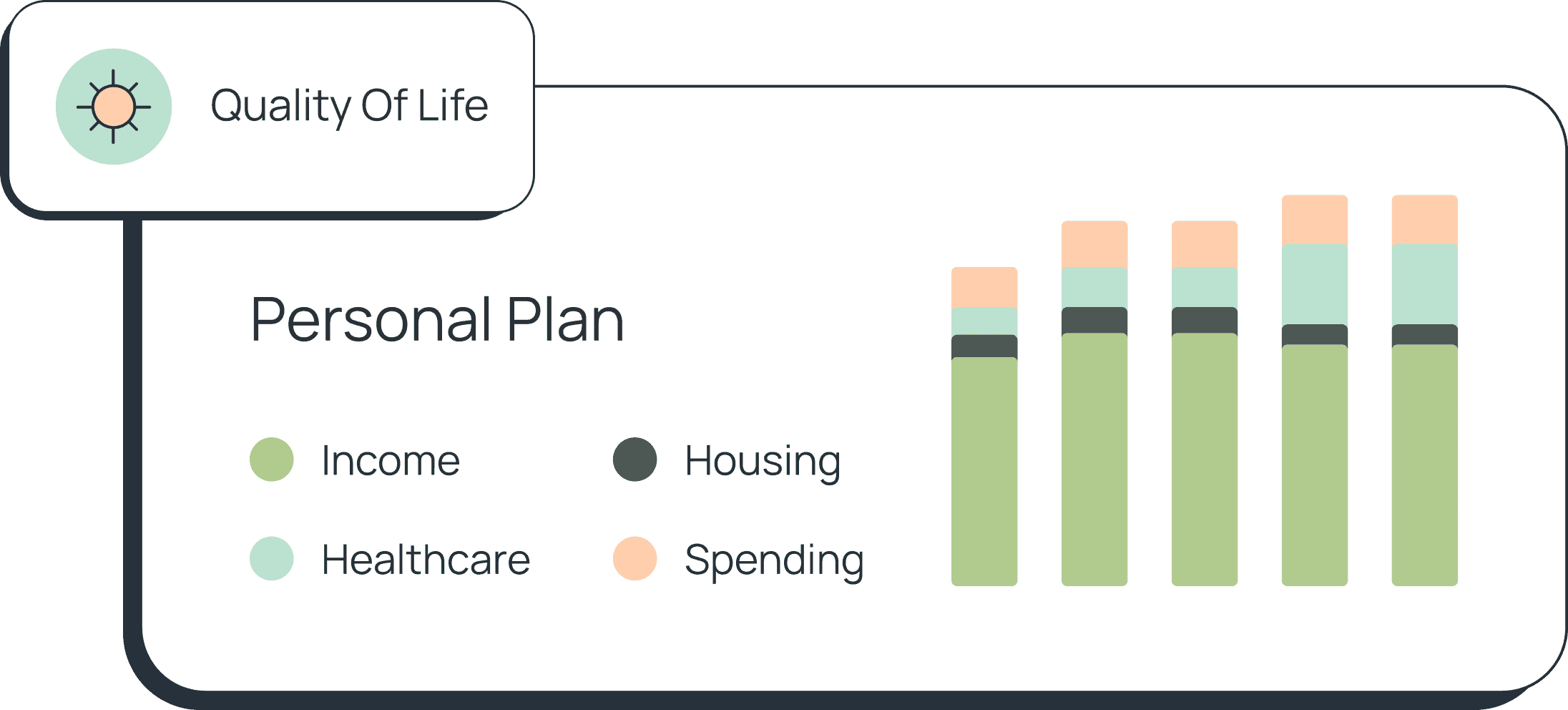Retirement Accounts
Do you have an inherited IRA? Here’s what spouse and non-spouse beneficiaries need to know to make the most of your inherited IRA and avoid penalties.

Michael Schultheiss
•
Published September 30th, 2020
•
Updated April 1st, 2024
Table of Contents
Key Takeaways
The rules for inheriting an IRA are different for spouses and non-spouses and they have changed recently.
Make sure to follow the correct set of rules to avoid IRS fees.
Talk to a Certified Financial Planner® for more help with your inherited IRA.
If you’ve inherited an IRA, you’re probably wondering what to do next. Do you have to pay taxes on it? When can you withdraw the money – and when do you have to, and for how long? Today we’ll cover these and other important questions about inherited IRAs.
Inheriting an IRA as a Spouse
If you’re inheriting an IRA as a spouse who is the sole beneficiary, you have the option of taking it over. This is sometimes called a spousal transfer, or “assuming” the IRA.
What does this mean for you? It means that as far as the IRS is concerned, your inherited IRA (also called a beneficiary IRA) has been yours all along. You will receive all of the benefits from it.
You have a few different options for the way in which you assume your inherited IRA. One option is to simply take the assets from the account and put them into another IRA you own. If you do this, the inherited IRA and the one you already owned must have the same tax treatment (i.e. they both must be a traditional IRA or both be a Roth IRA).
Another way is to simply designate yourself the owner of the inherited IRA. This means you contact the firm that manages the IRA and fill out a form taking over the account in your own name. A third way is to set up a new account and have the funds deposited into this account.
If you are a spouse but not the sole beneficiary, or a non-spouse who is inheriting in whole or in part, a different set of rules applies.
Inheriting an IRA as a non-spouse
If the IRA you inherited is not from a spouse, or if it is but you are not the sole beneficiary, the inherited IRA rules are a bit stricter. The key thing you cannot do as a non-spouse or as a spouse who is not the sole beneficiary is to transfer or “roll” your beneficiary IRA into an existing account you own.
What you need to do instead is set up a new IRA and formally name it an inherited IRA. For example, if Person X dies and bequeaths an IRA to Person Y, then Person Y will set up an IRA called “Person X for the benefit of Person Y”. They will have to file out a change of beneficiary form with the firm that manages the IRA.
Once you have your new inherited IRA, you can transfer the funds you have inherited into it. Whether you are a non-spouse sole inheritor, non-spouse partial inheritor, or spouse who is a partial inheritor, you will not be able to make more contributions to your inherited IRA.
Withdrawing from an Inherited IRA
You have your inherited IRA set up. Now you want to start taking withdrawals. But what are the inherited IRA rules for withdrawals?
One thing to know up front is that most non-spouse beneficiaries must withdraw all funds from an inherited IRA within 10 years of the death of the person they inherited it from. This is a new inherited IRA rule that applies to all inherited IRAs where the owner passed after December 31, 2019.
Let’s cover a few more rules that govern inherited IRA withdrawals. As we will see, there are also some exceptions to the 10-year rule.
Taxes on inherited IRA
You will have to pay taxes on your inherited traditional IRA after you make withdrawals. This is the same rule as with traditional IRAs held by the original account owner: every withdrawal counts as income subject to tax in that tax year. The rules for Roth 401(k)s are a bit more complicated, and we’ll cover them below.
With that said, you still have the option to withdraw whenever you want and as much or as little as you want, provided the account is empty within the 10-year allotted time frame.
Let’s turn now to some exceptions to the 10-year rule.
Withdrawals on IRAs inherited as a spouse (sole beneficiary)
If you are a spouse who inherited an IRA as sole beneficiary, the 10-year rule simply does not apply if you assume the IRA and treat it as your own. Because it is your own, standard IRA rules apply. Under those circumstances, you will probably have to start taking required minimum distributions (RMDs), depending on your age. We’ll address those below.
Withdrawals for a minor child
The rules are a bit different for minor children who inherit IRAs. So long as they are minors, they must start taking withdrawals, but these will be based on life expectancy. Once the young person reaches the age of majority, 18 in most states, they will then have 10 years to deplete any remaining funds from the inherited IRA.
Withdrawals for a chronically ill or disabled person
People who are chronically ill or disabled have more options when they inherit IRAs. Specifically, they can extend the withdrawals out over their lifetimes. Whether or not this is the best option will depend on the person and the circumstances, but it is an option.
Withdrawals when the beneficiary is not more than 10 years younger
If you are close in age to the person you inherited the IRA from, no more than 10 years, you have the option of stretching withdrawals out over your lifetime. This rule applies not only to spouses but also to non-spouses, giving an additional degree of flexibility to people who are in this situation.
Withdrawals on Roth IRAs
If you have inherited a Roth IRA, you can withdraw contributions – as opposed to earnings – at any time, tax-free. Additionally, if your inherited Roth IRA was open for at least five years at the time the account holder died, you can also withdraw earnings tax-free.
This is known as the 5-year rule, and it is important to be aware of. If your inherited Roth IRA was less than 5 years old when the owner died, you will owe taxes on earnings, but not contributions, when you withdraw.
IRA RMD Rules and Penalties
When you inherit an IRA, you will typically have to start taking required minimum distributions (RMDs).
The general rule for RMDs is that once you reach 72, or 70 and ½ if you reach that age before January 1, 2020, you will have to start taking RMDs in that year.
This rule also generally applies to IRAs. As a rule, you have to start taking RMDs for inherited IRAs by December 31 of the year after the original owner’s death, except for the exceptions we have already covered.
However, if the original owner was not 70 and ½ when they died, you have the option of the 5-year rule: so long as you have depleted the account by December 31 of the fifth anniversary year following the owner’s death, you do not need to take RMDs.
Failing to take RMDs when you are supposed to incurs a penalty of 50%, so it is in your interest to make sure you take them if you are supposed to.
Bottom Line
If you have an inherited IRA, it can provide an important source of financial security in your time of bereavement. Given the various rules and options, it can be challenging to figure out what to do. It’s important to talk things through with an expert to make sure you understand what your options are, how to make the most of this asset, and how to avoid any preventable penalties.
Talk to a Certified Financial Planner® today to help you make the right financial decision for you and your specific situation.
Frequently Asked Questions
What happens when I inherit an IRA?
When you inherit an Individual Retirement Account (IRA), you become the beneficiary and must adhere to specific rules for managing, withdrawing from, and paying taxes on the account, depending on your relationship to the original owner and the type of IRA (Traditional or Roth).
Are the rules different for spouses vs. non-spouse beneficiaries?
Yes, the rules for inheriting an IRA differ significantly between spouses and non-spouse beneficiaries:
- Spouses can transfer the inherited IRA assets into their own IRA, allowing them more flexibility in managing the account and taking distributions.
- Non-spouse beneficiaries cannot transfer inherited IRA assets into their own IRAs and are subject to different distribution requirements.
What are the distribution rules for inherited IRAs?
As of the latest regulations, most non-spouse beneficiaries must withdraw all assets from an inherited IRA within 10 years following the year of the IRA owner's death. This rule applies regardless of whether the IRA is Traditional or Roth. Spousal beneficiaries have more options, including the ability to treat the IRA as their own or follow the same 10-year distribution rule.
Do I have to pay taxes on distributions from an inherited IRA?
- Traditional IRA: Yes, distributions are typically taxable as income at your current tax rate.
- Roth IRA: No, distributions are usually tax-free as long as the original account was opened at least five years before taking distributions.
Can I continue to contribute to an inherited IRA?
No, beneficiaries cannot make additional contributions to an inherited IRA. The account is meant solely for distributing the original owner's assets.
What if the original IRA owner had not yet started taking Required Minimum Distributions (RMDs)?
If the original owner was under the age where RMDs are mandatory (currently 72) and had not started taking them, the non-spouse beneficiary must either withdraw the entire account balance within 10 years or begin taking annual distributions based on their life expectancy.
Are there exceptions to the 10-year withdrawal rule?
Certain eligible designated beneficiaries, including minor children of the original account holder, disabled or chronically ill individuals, and beneficiaries not more than 10 years younger than the account holder, may be allowed to take distributions based on their life expectancy instead of within the 10-year limit.
Share this advice

Michael Schultheiss is a freelance copywriter of long-form content and other marketing communications (B2B and B2C) in the financial services and FinTech niches. In copywriting, he looks for hungry crowds. Other interests include health, fitness, and reading and writing fiction.
Share this advice

Michael Schultheiss is a freelance copywriter of long-form content and other marketing communications (B2B and B2C) in the financial services and FinTech niches. In copywriting, he looks for hungry crowds. Other interests include health, fitness, and reading and writing fiction.




